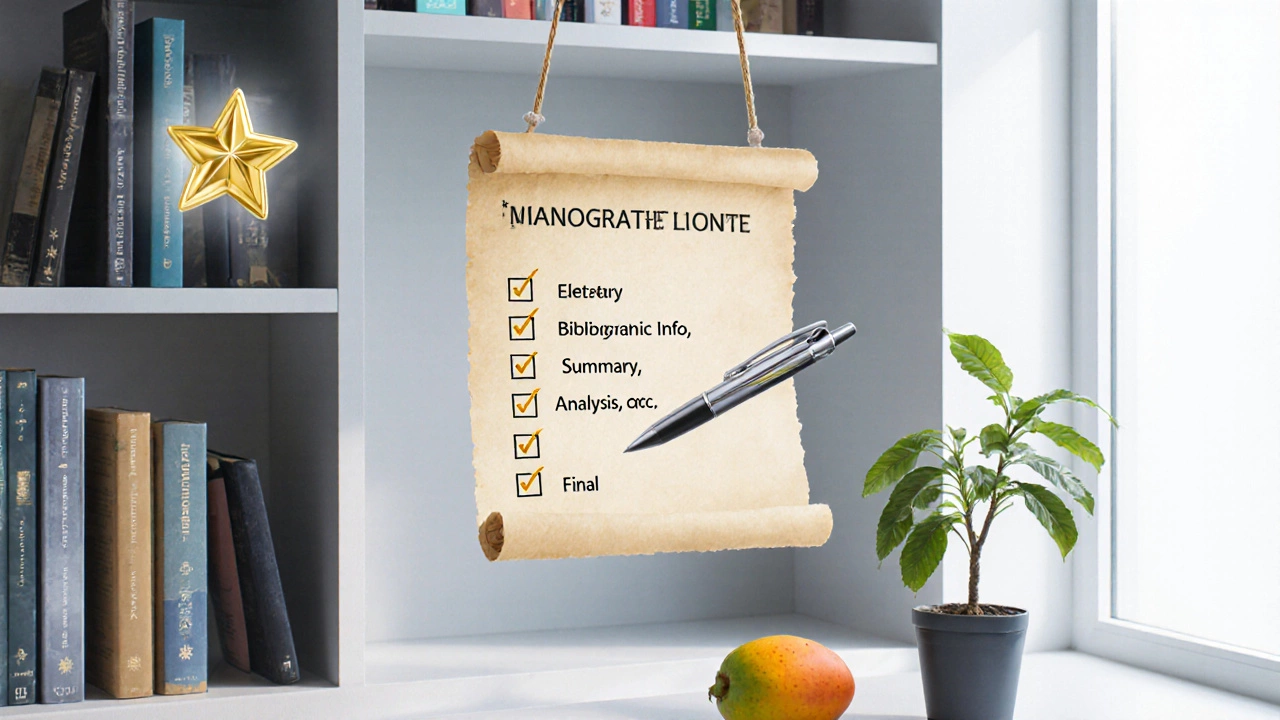
Book Review Outline Builder
Build Your Review Outline
Follow the standard book review pattern to create a professional, structured review. Fill in each section to generate your outline.
1. Bibliographic Information
2. Review Hook
3. Summary (3-5 sentences)
4. Analysis & Evaluation
5. Critical Assessment
6. Conclusion & Rating
When you pick up a Book review a critical essay that evaluates a recently published work, you expect a clear pattern that tells you what to expect and how the reviewer reached their verdict. Understanding that pattern saves you time, helps you write better reviews, and lets you compare opinions across platforms. Below is the full breakdown of the classic book review pattern, why each part matters, and how to adapt it for blogs, newspapers, or community sites.
What Exactly Is a Book Review?
A book review is a short‑to‑medium‑length piece that combines summary, analysis, and personal evaluation. It typically appears in print media, online blogs, or community sites like Goodreads. The goal is to give readers enough information to decide whether to invest time and money in the book while respecting the author’s work.
Core Components of a Standard Review
- Bibliographic information - Title, author, publisher, year, ISBN, and often the genre.
- Brief summary - A concise overview of plot or argument without spoilers.
- Thematic or structural analysis - Discussion of main ideas, narrative techniques, pacing, and style.
- Character or subject evaluation - For fiction: depth of characters, dialogue. For non‑fiction: credibility of sources, logical flow.
- Author context - Brief bio, previous works, and how this book fits into their career.
- Critical assessment - Strengths, weaknesses, originality, and relevance to its field or genre.
- Conclusion and rating - Final recommendation, often expressed as stars, a numeric score, or a simple “read/not read.”
These elements appear in roughly the same order in most professional reviews, creating a recognizable pattern that readers trust.
Step‑by‑Step Pattern Most Reviewers Follow
- Start with the bibliographic header. Give the reader the basic facts right away.
- Provide a hook - a single sentence that grabs attention, often a striking quote or a bold claim.
- Offer a spoiler‑free summary that sets the scene.
- Delve into analysis: discuss themes, style, pacing, and any literary devices that stand out.
- Comment on characters or the author’s expertise, linking back to the summary.
- Present your critical assessment, weighing strengths against shortcomings.
- Wrap up with a clear recommendation and, if the outlet uses one, a rating.
Following this sequence helps the review flow logically and makes it easier for editors to edit or for readers to skim.

Platform Variations: How the Pattern Shifts
Not every outlet follows the full template. Below is a quick comparison of how three popular platforms slice the pattern.
| Platform | Key Sections | Length |
|---|---|---|
| New York Times | Bibliographic info, summary, analysis, cultural context, rating | 800‑1200 words |
| Goodreads | Brief summary, personal reaction, star rating, tags | 150‑300 words |
| Kirkus Reviews | Opening hook, concise summary, critical assessment, recommendation | 400‑600 words |
Notice how the New York Times keeps the full pattern, while Goodreads trims everything to a quick impression, and Kirkus sticks to a middle ground.
Writing Tips for Each Section
Bibliographic info: Always include the ISBN; it lets readers locate the exact edition you’re reviewing. Example: ISBN 978‑0143127741.
Hook: Use a compelling line from the book or a provocative question. “What if you could relive the worst day of your life, over and over?” works for a dystopian novel.
Summary: Aim for 3‑5 sentences. Focus on the premise, not the ending. For non‑fiction, state the thesis and main arguments.
Analysis: Cite specific passages. Mention literary techniques-e.g., “the author’s use of flashback creates a fragmented timeline that mirrors the protagonist’s memory loss.”
Character evaluation: Discuss growth, motivation, and believability. Avoid spoilers by referring to characters in general terms.
Author context: A one‑sentence bio works. “Rohinton Mistry, acclaimed for his portrayals of Indian diaspora, returns with a novel set in 1970s Mumbai.”
Critical assessment: Balance praise with critique. Use comparative language: “Unlike Neil Gaiman’s whimsical tone, this work feels overly earnest.”
Conclusion & rating: State “I recommend this book to fans of historical thrillers” and add a rating like “4 out of 5 stars.”
Real‑World Example Breakdown
Below is a snippet from a review of The Night Circus by Erin Morgenstern, showing the pattern in action (the full review is 1,050 words).
Bibliographic info: Morgenstern, Erin. The Night Circus. Anchor Books, 2011. ISBN 978‑0385534635.
Hook: “The circus arrives without warning, and leaves no trace, but its magic lingers forever.”
Summary: The novel follows two young illusionists locked in a competition that becomes a love story, set against a wandering, black‑and‑white circus that appears only at night.
Analysis: Morgenstern’s lush prose and non‑linear timeline echo the circus’s dreamlike quality, while the recurring motif of mirrors underscores themes of identity.
Character evaluation: Celia and Marco are compelling; their rivalry feels genuine, though secondary characters sometimes drift into the background.
Author context: This debut novel catapulted Morgenstern to bestseller status and earned a Hugo nomination.
Critical assessment: The narrative’s pacing lagged in the middle, but the climax delivers a satisfying payoff.
Conclusion & rating: A spellbinding read for fans of magical realism - 4.5/5 stars.
Notice how each component follows the established pattern, making the review easy to follow.

Checklist Before You Hit Publish
- Did you include full bibliographic details, including ISBN?
- Is the summary spoiler‑free and under 5 sentences?
- Did you reference at least two specific passages?
- Do you mention the author’s background in one concise sentence?
- Have you balanced praise and critique?
- Is the rating consistent with the outlet’s system?
- Did you proofread for grammar and flow?
Running through this list ensures you hit every part of the pattern.
Common Questions About the Review Pattern
Do I have to include a star rating?
Only if the publication or platform uses a rating system. Blogs can replace stars with a simple “recommended” or “not recommended.”
How long should the analysis section be?
For a standard newspaper review, aim for 250‑350 words. For a short online post, 100‑150 words suffices. The key is depth, not length.
Can I skip the author context?
If the author is a debut with no notable backstory, a brief mention is enough. Established writers benefit from a quick career snapshot.
Is it okay to include spoilers?
Generally avoid major plot twists. If a spoiler is essential for analysis, preface it with a warning and keep it minimal.
What’s the difference between a review and a synopsis?
A synopsis merely recounts the story, while a review evaluates the work’s quality, themes, and impact.
Wrapping Up
Mastering the book review pattern lets you produce clear, persuasive critiques that readers trust. Whether you’re writing for a major newspaper, a personal blog, or a community forum, stick to the core components, adapt the length to the platform, and use the checklist to avoid common pitfalls. Soon you’ll recognize the pattern instinctively, and your reviews will become a go‑to resource for fellow book lovers.


